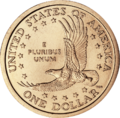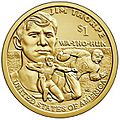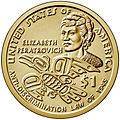Sacagawea dollar facts for kids
| United States | |
| Value | 1.00 United States dollar |
|---|---|
| Mass | 8.100 g (0.26 troy oz) |
| Diameter | 26.49 mm (1.043 in) |
| Thickness | 2.00 mm (0.079 in) |
| Edge | Plain (2000–2008) Lettered (2009–present) |
| Composition | Core: 100% Cu Cladding: 77% Cu, 12% Zn, 7% Mn, 4% Ni Overall: 88.5% Cu, 6% Zn, 3.5% Mn, 2% Ni |
| Years of minting | 2000–2001 (circulation) 2002–2008 (collectors only) 2009–2011 (circulation) 2012–present (collectors only) |
| Mint marks | P (Philadelphia) D (Denver) S (San Francisco) W (West Point, special strikings only) |
| Obverse | |
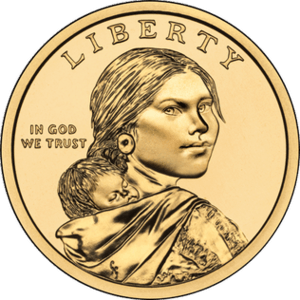 |
|
| Design | Profile of Sacagawea with her child, Jean Baptiste Charbonneau |
| Designer | Glenna Goodacre |
| Design date | 2000, modified 2009 |
| Reverse | |
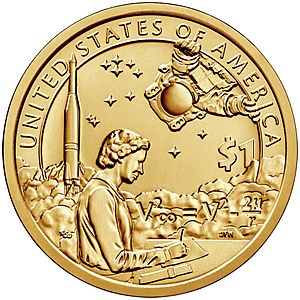 |
|
| Design | Mary G. Ross and American Indians in the Space Program |
| Designer | Emily Damstra |
| Design date | 2019 |
The Sacagawea dollar (also known as the "golden dollar") is a United States dollar coin that has been minted every year since 2000, although not released for general circulation from 2002 to 2008 and again from 2012 onward due to its general unpopularity with the public and low business demand for the coin. These coins have a copper core clad by manganese brass, giving them a distinctive golden color. The coin features an obverse by Glenna Goodacre. From 2000 to 2008, the reverse featured an eagle design by Thomas D. Rogers. Since 2009, the reverse of the Sacagawea dollar has been changed yearly, with each design in the series depicting a different aspect of Native American cultures.
The coin was first suggested as a replacement for the Susan B. Anthony dollar, which proved useful for vending machine operators and mass transit systems despite being unpopular with the public. The Statue of Liberty was originally proposed as the design subject, but Sacagawea, the Shoshone guide of the Lewis and Clark Expedition, was eventually chosen.
The new dollar coin was heavily marketed by the Mint in a series of print, radio, and television advertisements, as well as Mint partnerships with Walmart and Cheerios. However, the Sacagawea dollar did not prove popular with the public, and mintage dropped sharply in the second year of production. Production of Sacagawea dollars continued, from 2007 to 2016 in parallel with the U.S. Presidential dollars. In 2012, mintage numbers were reduced by over 90%, in line with a similar reduction for the Presidential Dollars, due to large stockpiles of unused dollar coins.
The Mint planned to issue the Sacagawea design in 22-karat gold as well, but this idea was quickly abandoned after the Mint's authority to strike the coins was questioned, and the Mint has retained ownership of the few such coins produced. Soon after initial production of the dollar, it was noticed that a few of the dollar coins were erroneously struck with the obverse of a state quarter and the normal reverse.
Images for kids
-
2010 reverse by Thomas Cleveland honors the Haudenosaunee nation and their Great Law of Peace
-
2014 reverse,
2017 reverse, designed by Chris Costello and engraved by Charles L. Vickers, depicts Sequoyah
-
2018 reverse by Michael Gaudioso featuring Jim Thorpe
-
2020 reverse, designed by Phebe Hemphill featuring Elizabeth Peratrovich
See also
 In Spanish: Dólar Sacagawea para niños
In Spanish: Dólar Sacagawea para niños





